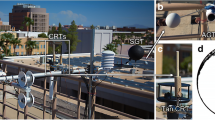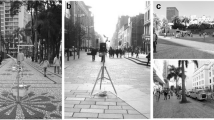Abstract
Mean radiant temperature (T mrt) values were calculated and compared to each other in Taiwan based on the six-directional and globe techniques. In the case of the six-directional technique (measurements with pyranometers and pyrgeometers), two different T mrt values were calculated: one representing the radiation load on a standing man [T mrt(st)] and the other which refers to a spherical reference shape [T mrt(sp)]. Moreover, T mrt(T g ) was obtained through the globe thermometer technique applying the standard black globe. Comparing T mrt values based on the six-directional technique but with different reference shapes revealed that the difference was always in the +/−5 °C domain. Of the cases, 75 % fell into the +/−5 °C Delta Tmrt range when we compared different techniques with similar reference shapes [T mrt(sp) and T mrt(T g )] and only 69 % when we compared the different techniques with different reference shapes [T mrt(st) and T mrt(T g )]. Based on easily accessible factors, simple correction functions were determined to make the T mrt(T g ) values of already existing outdoor thermal comfort databases comparable with other databases which involve sixdirectional T mrt. The corrections were conducted directly between the T mrt(T g ) and T mrt(sp) values and also indirectly, i.e., by using the values of T g to reduce the differences between T mrt(sp) and T mrt(T g ). Both correction methods resulted in considerable improvement and reduced the differences between the T mrt(sp) and the T mrt(T g ) values. However, validations with an independent database from Hungary revealed that it is not suggested to apply the correction functions under totally different background climate conditions.







Similar content being viewed by others
References
Abdel-Ghany AM, Al-Helal IM, Shady MR (2013) Human thermal comfort and heat stress in an outdoor urban arid environment: a case study. Adv Meteorol, Article ID 693541
Ali-Toudert F (2005) Dependence of the outdoor thermal comfort on street design in hot and dry climate. Ber Meteor Inst Albert-Ludwigs-Univ Freiburg 15:224p
Ali-Toudert F, Mayer H (2007) Thermal comfort in an east–west oriented street canyon in Freiburg (Germany) under hot summer conditions. Theor Appl Climatol 87:223–237
Ali-Toudert F, Djenane M, Bensalem R, Mayer H (2005) Outdoor thermal comfort in the old desert city of Beni-Isguen, Algeria. Clim Res 28:243–256
Andrade H, Alcoforado MJ (2008) Microclimatic variation of thermal comfort in a district of Lisbon (Telheiras) at night. Theor Appl Climatol 92:225–237
Andrade H, Alcoforado MJ, Oliveira S (2011) Perception of temperature and wind by users of public outdoor spaces: relationships with weather parameters and personal characteristics. Int J Biometeorol 55:665–680
ASHRAE (2001) Chapter 14—measurements and instruments. In: ASHRAE fundamentals handbook. American Society for Heating Refrigerating and Air-Conditioning Engineers, Atlanta:14.28–14.29
Bedford T, Warner CG (1934) The globe thermometer in studies of heating and ventilation. J Hyg (Lond) 34:458–473
Chen H, Ooka R, Harayama K, Kato S, Li X (2004) Study on outdoor thermal environment of apartment block in Shenzhen, China with coupled simulation of convection, radiation and conduction. Energ Buildings 36:1247–1258
Deb C, Ramachandraiah A (2010) Evaluation of thermal comfort in rail terminal location in India. Build Environ 45:2571–2580
Deb C, Ramachandraiah A (2011) A simple technique to classify urban locations with respect to human thermal comfort: proposing the HXG scale. Build Environ 46:1321–1328
Fanger PO (1972) Thermal comfort. McGraw Hill Book Co, New York, p 244
Gulyás Á, Unger J, Matzarakis A (2006) Assessment of the microclimatic and thermal comfort conditions in a complex urban environment: modelling and measurements. Build Environ 41:1713–1722
Holst J, Mayer H (2010) Urban human-biometeorology: investigations in Freiburg (Germany) on human thermal comfort. Urban Climate News 38:5–10
Höppe P (1992) Ein neues Verfahren zur Bestimmung der mittleren Strahlungstemperatur in Freien. Wetter und Leben 44:147–151
Höppe P (1999) The physiological equivalent temperature—a universal index for the biometeorological assessment of the thermal environment. Int J Biometeorol 43:71–75
Hwang RL, Lin TP (2007) Thermal comfort requirements for occupants of semi-outdoor and outdoor environments in hot-humid regions. Archit Sci Rev 50:357–364
Hwang RL, Lin TP, Cheng MJ, Lo JH (2010) Adaptive comfort model for tree. Shaded outdoors in Taiwan. Build Environ 45:1873–1879
Hwang RL, Lin TP, Matzarakis A (2011) Seasonal effects of urban street shading on long-term outdoor thermal comfort. Build Environ 46:863–870
ISO (1985) ISO Standard 7726. Thermal environments—instruments and methods for measuring physical quantities.
ISO (1998) ISO Standard 7726. Ergonomics of the thermal environments—instruments for measuring physical quantities.
Jendritzky G (1993) The atmospheric environment—an introduction. Experientia 49:733–738
Jendritzky G, Nübler W (1981) A model analysing the urban thermal environment in physiologically significant terms. Arch Met Geoph Biokl B 29:313–326
Kántor N, Unger J (2010) Benefits and opportunities of adopting GIS in thermal comfort studies in resting places: an urban park as an example. Landscape Urban Plan 98:36–46
Kántor N, Égerházi L, Unger J (2012a) Subjective estimations of thermal environment in recreational urban spaces—part 1: investigations in Szeged, Hungary. Int J Biometeorol 56:1075–1088
Kántor N, Unger J, Gulyás Á (2012b) Subjective estimations of thermal environment in recreational urban spaces—part 2: international comparison. Int J Biometeorol 56:1089–1101
Kántor N, Matzarakis A, Lin TP (2013) Daytime relapse of the mean radiant temperature based on the six-directional method under unobstructed solar radiation. Int J Biometeorol, DOI 10.1007/s00484-013-0765-5
Krüger EL, Rossi FA (2011) Effect of personal and microclimate variables on observed thermal sensation from a field study in southern Brazil. Build Environ 46:690–697
Krüger EL, Minella FO, Rasia F (2011) Impact of urban geometry on outdoor thermal comfort and air quality from field measurements in Curitiba, Brazil. Build Environ 46:621–634
Lee H, Holst J, Mayer H (2013) Modification of human-biometeorologically significant radiant flux densities by shading as local method to mitigate heat stress in summer within urban street canyons. Adv Meteorol 06:1–13
Lin TP (2009) Thermal perception, adaptation and attendance in a public square in hot and humid regions. Build Environ 44:2017–2026
Lin TP, Matzarakis A, Hwang RL (2010) Shading effect on long-term outdoor thermal comfort. Build Environ 45:213–221
Lin TP, de Dear R, Hwang RL (2011) Effect of thermal adaptation on seasonal outdoor thermal comfort. Int J Climatol 31:302–312
Lindberg F, Grimmond CSB (2011) The influence of vegetation and building morphology on shadow patterns and mean radiant temperatures in urban areas: model development and evaluation. Theor Appl Climatol 105:311–323
Lindberg F, Holmer B, Thorsson S (2008) SOLWEIG 1.0—modelling spatial variations of 3D radiant fluxes and mean radiant temperature in complex urban settings. Int J Biometeorol 52:697–713
Matzarakis A, Rutz F, Mayer H (2007) Modelling radiation fluxes in simple and complex environments—application of the RayMan model. Int J Biometeorol 51:323–334
Matzarakis A, Rutz F, Mayer H (2010) Modelling radiation fluxes in simple and complex environments: basics of the RayMan model. Int J Biometeorol 54:131–139
Mayer H (1993) Urban bioclimatology. Experientia 49:957–963
Mayer H (2008) KLIMES—a joint research project on human thermal comfort in cities. Ber Meteor Inst Albert-Ludwigs-Univ Freiburg 17:101–117
Mayer H, Höppe P (1987) Thermal comfort of man in different urban environments. Theor Appl Climatol 38:43–49
Mayer H, Holst J, Dostal P, Imbery F, Schindler D (2008) Human thermal comfort in summer within an urban street canyon in Central Europe. Meteorol Z 17:241–250
Ng E, Cheng V (2012) Urban human thermal comfort in hot and humid Hong Kong. Energ Buildings 55:51–65
Nikolopoulou M, Lykoudis S (2006) Thermal comfort in outdoor urban spaces: analysis across different European countries. Build Environ 41:1455–1470
Nikolopoulou M, Lykoudis S (2007) Use of outdoor spaces and microclimate in a Mediterranean urban area. Build Environ 42:3691–3707
Nikolopoulou M, Steemers K (2003) Thermal comfort and psychological adaptation as a guide for designing urban spaces. Energ Buildings 35:95–101
Nikolopoulou M, Baker N, Steemers K (2001) Thermal comfort in outdoor urban spaces: understanding the human parameter. Sol Energy 70:227–235
Oliveira S, Andrade H (2007) An initial assessment of the bioclimatic comfort in an outdoor public space in Lisbon. Int J Biometeorol 52:69–84
Pearlmutter D, Jiao D, Garb Y (2014) The relationship between bioclimatic thermal stress and subjective thermal sensation in pedestrian spaces. Int J Biometeorol, DOI 10.1007/s00484-014-0812-x
Shashua-Bar L, Tsiros IX, Hoffman M (2012) Passive cooling design options to ameliorate thermal comfort in urban streets of a Mediterranean climate (Athens) under hot summer conditions. Build Environ 57:110–119
Spagnolo J, de Dear RJ (2003) A field study of thermal comfort in outdoor and semi-outdoor environments in subtropical Sydney Australia. Build Environ 38:721–738
Streiling S, Matzarakis A (2003) Influence of single and small clusters of trees o the bioclimate of a city: a case study. J Arboriculture 29:309–316
Tan CL, Wong NH, Jusuf SK (2013) Outdoor mean radiant temperature estimation in the tropical urban environment. Build Environ 64:118–129
Tan CL, Wong NH, Jusuf SK (2014) Effects of vertical greenery on mean radiant temperature in the tropical urban environment. Landscape Urban Plan 127:52–64
Thorsson S, Lindqvist M, Lindqvist S (2004) Thermal bioclimatic conditions and patterns of behaviour in an urban park in Göteborg, Sweden. Int J Biometeorol 48:149–156
Thorsson S, Lindberg F, Holmer B (2007) Different methods for estimating the mean radiant temperature in an outdoor urban setting. Int J Climatol 27:1983–1993
VDI (1998) Methods for the human-biometeorological assessment of climate and air hygiene for urban and regional planning. Part I: climate. VDI 3787, Part 2. Beuth, Berlin, 29p
Vernon HM (1930) The measurement of radiant heat in relation to human comfort. J Physiol 70, Proc, 15p
Walton D, Dravitzki V, Donn M (2007) The relative influence of wind, sunlight and temperature on user comfort in urban outdoor spaces. Build Environ 42:3166–3175
Acknowledgment
The authors would express a special thank for the sponsorship of the Research Center for the Humanities and Social Sciences at the National Chung Hsing University.
Author information
Authors and Affiliations
Corresponding author
Rights and permissions
About this article
Cite this article
Kántor, N., Kovács, A. & Lin, TP. Looking for simple correction functions between the mean radiant temperature from the “standard black globe” and the “six-directional” techniques in Taiwan. Theor Appl Climatol 121, 99–111 (2015). https://doi.org/10.1007/s00704-014-1211-2
Received:
Accepted:
Published:
Issue Date:
DOI: https://doi.org/10.1007/s00704-014-1211-2




